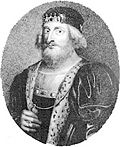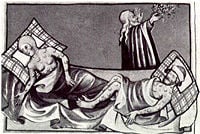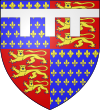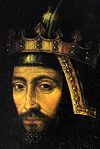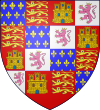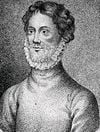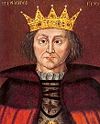Philippa of Hainault
| Philippa of Hainault | |
|---|---|
| Queen consort of England | |
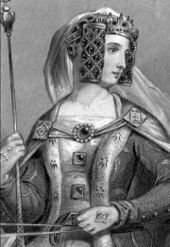
| |
| Consort | January 24, 1328 - August 15, 1369 |
| Consort to | Edward III |
| Issue | |
| Edward, the Black Prince Isabella, Lady of Coucy Joan of England Lionel, 1st Duke of Clarence John, 1st Duke of Lancaster Edmund, 1st Duke of York Mary, Duchess of Brittany Margaret, Countess of Pembroke Thomas, 1st Duke of Gloucester | |
| Titles | |
| Her Grace The Queen Lady Philippa of Hainault | |
| Royal House | Plantagenet |
| Father | William I, Count of Hainaut |
| Mother | Joan of Valois |
| Born | June 24 1311 Valenciennes |
| Died | 15 August 1369 (aged 58) Windsor Castle |
| Buried | Westminster Abbey |
Philippa of Hainault (June 24, 1311 – August 15, 1369) was the queen consort of Edward III of England. Born in Hainaut, Flanders (today France) she was married to Edward at 16, and they had 14 children, from whom all subsequent English monarchs are descended.
She is remembered as a gentle queen who persuaded her husband to spare the lives of the Burghers of Calais after his victory there in 1346. Yet, as regent during her husband's absence on the Continent, Philippa raised an army and won the battle of Neville's Cross, taking the Scottish King David II Bruce prisoner.
Philippa was known as a kind and loving woman who was loved by her British subjects, and her marriage was a successful one. After her death, however, a violent struggle broke out among her sons and grandsons for the throne of England, which led to the Wars of Roses.
Philippa survived all but five of her children during her 40-year marriage and died at 58 from dropsy. She was buried at Westminster Abbey, and eight years later her husband was laid to rest beside her. The Queen's College, Oxford is named after Philippa.
Life
Philippa was born in Valenciennes in the County of Hinault and was the daughter of William I, Count of Hainaut (d. 1337)[1] and Jeanne of Valois, (d. 1352) the granddaughter of Philip III of France. She was raised in the cultured court of Hainault where she developed literary tastes and an interest in learning.
Her marriage to King Edward III of England was arranged by Edward's mother, Isabella of France. They were second cousins who had met previously and enjoyed each other's company. On January 24, 1328, they were married—he was 15 and she was 16—11 months after his accession to the English throne, following the death of his father. However, Edward's mother, Isabella, ruled as regent together with her lover, Roger Mortimer, the real power behind the throne.
Philippa was crowned as queen in 1330 in which year she also gave birth to a son. Unlike many of her predecessors, she did not alienate the English people by retaining her foreign retinue upon her marriage or bringing large numbers of foreigners to the English court.
When Edward was nearly 18, he determined to govern the kingdom without the influence of his domineering mother and her lover Mortimer. He thus staged a coup, exiled his mother up in Castle Rising, and sent Mortimer to the Tower of London, where he was sentenced to die. Edward then began a series of reforms to correct abuses caused by Isabella and Mortimer, engaged in various military campaigns, and encouraged trade with other nations.
Unlike many queens, Philippa accompanied her husband on his military expeditions, for example to the Kingdom of Scotland (1333) and Flanders (1338-40), where she won acclaim for her gentleness and compassion. She is best remembered as the tender-hearted woman who interceded with her husband and persuaded him to spare the lives of the Burghers of Calais (1346) whom he had planned to execute as an example to the townspeople following his successful siege of the city. She reportedly told him such an act would be bad for the baby with which she was currently pregnant.
Philippa was appointed regent of England by Edward when he was absent on the Continent. At this time, the Scots invaded England as far south as Durham in 1346. Philippa raised an army and, challenging the enemy on a white horse, inspired her forces to win the battle of Neville's Cross, taking the Scottish King David II Bruce prisoner.
She also brought Flemish weavers to teach the English the craft, beginning with a little colony at Norwich, often going herself to look after them and encourage their work. She also encouraged coal-mining. She made the French poet and historian Jean Froissart her secretary. It was during the reign of her husband that English became the "official" language in 1363.
Edward and Philippa were reported to have been loving parents, doting on their brood. Philippa breast-fed her children, which was virtually unheard of among the fourteenth-century nobility. The royal couple did not force their eldest son, Edward, into a loveless marriage. Instead, he was allowed to marry for love relatively late in life, to Joan, his second cousin.
Philippa had grown portly in her later years, and this added to the view most of her English subjects had of her as a friendly, homely, motherly woman whom the nation greatly loved. She outlived nine of her 14 children; two of whom were lost during the Black Death outbreak in 1348.
Unfortunately, rivalry found its way into the family of Philippa's grown sons and grandsons, which ultimately led to various challenges to the throne and the ensuing Wars of Roses. She did not live to see the sad changes leading up to the struggles which made her son Edward II's life so tragic; nor did she live to see her husband become a helpless old man whose throne became such an object of contention among his sons and grandsons.
As she lay dying, Philippa reportedly asked Edward:
"We have, my husband, enjoyed our long union in peace and happiness, but before we are forever parted in this world, I entreat you will grant me three requests." "Lady, name them," answered Edward, "they shall be granted." "My lord," she whispered, "I beg you will pay all the merchants I have engaged for their wares; I beseech you to fulfill any gifts or legacies I have made to churches and my servants; and when it shall please God to call you hence, that you will lie by my side in the cloisters of Westminster Abbey." As she passed, the king was in tears. "Lady," he said, "all this shall be done."[2]
On August 15, 1369, Philippa died of an illness akin to dropsy[3] in Windsor Castle. She was buried at Westminster Abbey. By all accounts, her 40 year marriage to Edward had been happy, despite his taking a mistress, Alice Perrers (a young, successful landowner), during the later part of it.
Legacy
Oftentimes a royal woman was seen only as a vehicle to produce an heir. Philippa outdid herself becoming literally the foremother of all future English monarchs. She also produced many heirs who married into other royal families of Europe in the fourteenth century.
Philippa and Edward had 14 children, including five sons who lived into adulthood and whose rivalry would eventually bring about the long-running civil wars known as the Wars of the Roses. Their sons are:
- Edward, the Black Prince (1330-76), "black" refers to his black breast plate and helmet. He was father to King Richard II, and married his cousin, Joan of Kent. He was a founding member of the Order of the Garter, an English patriotic royal order which signified a shift away from the crusader mentality. He died before his own father did so he never became king.
- Lionel of Antwerp, 1st Duke of Clarence (1338-68), married Elizabeth de Burgh, 4th Countess of Ulster, in 1352, received her great Irish land inheritance and in 1347 became the Earl of Ulster. He became the Duke of Clarence in 1361, but was unable to gain control over the Irish people and lands. His wife died in 1363 in Dublin, and their daughter Philippa's descendants would claim the throne for the House of York.[4]
- John of Gaunt, 1st Duke of Lancaster (1340-99), was born in Ghent then called "Gaunt," who supported his weak nephew Richard II until he died. He married three times, producing 14 children. His first wife was Blanche of Lancaster. John's legitimate male heirs, the Lancasters, included Kings Henry IV (son of Blanche) and his descendants, Henry V, and Henry VI. One daughter, Philippa of Lancaster, became Queen consort of John I of Portugal and mother of King Edward of Portugal. Philippa gave birth to several famous princes and princesses of Portugal that became known as the "Illustrious Generation." John of Gaunt then married Constance and fathered Katherine of Lancaster, Queen consort of Henry III of Castile, mother of John II of Castile. He finally married Katherine Swynford, and their descendants included Kings Edward IV, Richard III, Henry VII and the subsequent monarchs of the House of Tudor. All English monarchs from Henry IV on are descendants of John of Gaunt.
- Edmund of Langley, 1st Duke of York (1341-1402), his son Richard was instrumental in the challenge to the English throne in the Wars of Roses. One daughter, Isabella, was ancestor of Kings Edward IV, V and Richard III. He then married Joan Holland but they had no children.
- Thomas of Woodstock, 1st Duke of Gloucester (1355-97), Philippa's 14th child. He married Eleanor de Bohan and inherited the title of Earl of Essex. His wife's younger sister married Henry Bolingbroke/Henry IV who led the group against Richard II.
Another three sons and two daughters died in infancy. There were four surviving daughters:
- Isabella of England (1332-1379), married Enguerrand VII of Coucy at age 33.
- Joan of England (1334-1348), betrothed to Castro of Castile but died from the Black Death before she met him.
- Mary Plantagenet (1344-1362), betrothed to John V of Brittany, they grew up in the same household together. They married in 1361 and they became the Duke and Duchess of Brittany, but three weeks later she became lethargic and died. She was buried next to her sister Margaret, who died just weeks before.
- Margaret Plantagenet (1346-1361), was betrothed to John V of Brittany but Mary married him instead. She grew up in the same house with John Hastings and thus married him at age 13, in 1359, but died two years later.
Through her children, Philippa also reintroduced the bloodline of an earlier English King, Stephen, into the royal family.
In her husband's absence in the Continent, she was appointed regent and when the Scottish King David Bruce invaded England, Philippa raised an army and, challenging the enemy on a white horse, inspired her forces to win the battle of Neville's Cross, taking him prisoner.
The Queen's College, Oxford is named after Philippa. It was founded by one of her chaplains, Robert de Eglesfield, in her honor and placed under her care and protection.
Notes
- ↑ Her father's name is both of Hainaut and Hainault, not to be confused with the area called Hainault near London.
- ↑ The Baldwin Project: Philippa of Hainault mainlesson.com. Retrieved November 7, 2008.
- ↑ A swelling from excessive accumulation of watery fluid in cells, tissues, or serous cavities [syn: edema].
- ↑ Philippa married Edmund Mortimer, 3rd Earl of March in 1368. Her granddaughter, Anne Mortimer married into the York branch of the royal family which was the basis of the House of York's claim to the throne.
ReferencesISBN links support NWE through referral fees
- Ashley, Mike. British Kings & Queens. Carroll & Graf, 2002. ISBN 978-0786711048
- Fraser, Antonia. The Lives of the Kings and Queens of England. University of California Press, 2000. ISBN 978-0520224605
- Salmonson, Jessica Amanda. The Encyclopedia of Amazons. Paragon House, 1991. ISBN 978-1557784209
- Weir, Alison. Britain's Royal Family: A Complete Genealogy. The Bodley Head London, U.K.: Pimlico, 2002. ISBN 978-0712642866
External links
All links retrieved November 23, 2022.
George, Duke of Cumberland (1702-1707) · Mary of Modena (1685-1688) · Catherine of Braganza (1662-1685) · Henrietta Maria of France (1625-1649) · Anne of Denmark (1603-1619) · Philip II of Spain (1554-1558) · Lord Guildford Dudley (1553) · Catherine Parr (1543-1547) · Catherine Howard (1540-1542) · Anne of Cleves (1540) · Jane Seymour (1536-1537) · Anne Boleyn (1533-1536) · Catherine of Aragon (1509-1533) · Elizabeth of York (1486-1503) · Anne Neville (1483-1485) · Elizabeth Woodville (1464-1483) · Margaret of Anjou (1445-1471) · Catherine of Valois (1420-1422) · Joanna of Navarre (1403-1413) · Isabella of Valois (1396-1399) · Anne of Bohemia (1383-1394) · Philippa of Hainault (1328-1369) · Isabella of France (1308-1327) · Marguerite of France (1299-1307) · Eleanor of Castile (1272-1290) · Eleanor of Provence (1236-1272) · Isabella of Angoulême (1200-1216) · Berengaria of Navarre (1191-1199) · Eleanor of Aquitaine (1154-1189) · Matilda of Boulogne (1135-1152) · Geoffrey V, Count of Anjou (1141) · Adeliza of Louvain (1121-1135) · Matilda of Scotland (1100-1118) · Matilda of Flanders (1066-1083)
Credits
New World Encyclopedia writers and editors rewrote and completed the Wikipedia article in accordance with New World Encyclopedia standards. This article abides by terms of the Creative Commons CC-by-sa 3.0 License (CC-by-sa), which may be used and disseminated with proper attribution. Credit is due under the terms of this license that can reference both the New World Encyclopedia contributors and the selfless volunteer contributors of the Wikimedia Foundation. To cite this article click here for a list of acceptable citing formats.The history of earlier contributions by wikipedians is accessible to researchers here:
The history of this article since it was imported to New World Encyclopedia:
Note: Some restrictions may apply to use of individual images which are separately licensed.
